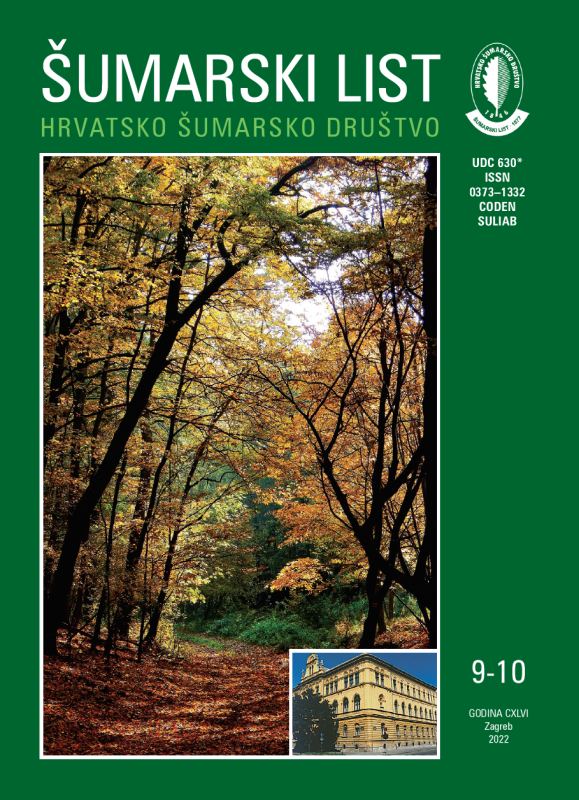
broj: 9-10/2022
pdf (15,8 MB) |
|
||||||||||||||
| RIJEČ UREDNIŠTVA | ||
| Uredništvo | ||
| Forests in the service of decentralisation and demographic recovery of Croatia pdf HR EN | 385 | |
| IZVORNI ZNANSTVENI ČLANCI | ||
| Tomislav Poršinsky, Zdravko Pandur, Zoran Bumber, Mihael Lovrinčević, Branko Ursić, Andreja Đuka | UDK 630* 312 (001) https://doi.org/10.31298/sl.146.9-10.1 | |
| Dimensional and mass characteristics of forwarders pdf HR EN | 387 | |
| Ping Qin, Ying Huang, Wenjun Zheng, Haitao Yu, Qing Zhang, Zhiyuan Xie, Yangyang Gao, Yichuan Bu, Yu Gan | UDK 630* 231 (001) https://doi.org/10.31298/sl.146.9-10.2 | |
| Factors of Natural Regeneration of Platycladus orientalis (L.) Franco in Guilin, China pdf HR EN | 403 | |
| Emrah Erdog˘an, Hayati Zengin, Mehmet Özcan, Ahmet Salih Deg˘ermenci, Necmi Aksoy | UDK 630* 232.4 (001) https://doi.org/10.31298/sl.146.9-10.3 | |
| Plant diversity indices for trojan fir stands in Aladag¨ region of Bolu pdf HR EN | 415 | |
| Vladimir Petković, Dane Marčeta, Igor Potočnik | UDK 630* 319 https://doi.org/10.31298/sl.146.9-10.4 | |
| Optimization of primary forest accessibility in high forests with natural regeneration pdf HR EN | 427 | |
| PRETHODNO PRIOPĆENJE | ||
| Milan Pernek, Marta Kovač, Andrija Jukić , Tomislav Dubravac, Nikola Lacković, Carrie Brady | UDK 630*459+111.8 https://doi.org/10.31298/sl.146.9-10.5 | |
| Acute oak decline (AOD) new complex disese on holm oak (Quercus ilex L.) and possibilities of spread on other oak species in Croatia pdf HR EN | 439 | |
| Slavko Mladenović, Milan Malinić, Boris Radić, Dragica Vilotić, Srđan Stamenković, Dragan Gačić | UDK 630* 156 https://doi.org/10.31298/sl.146.9-10.6 | |
| Monitoring of reintroduced red deer in the area of Tara (Western Serbia): incidence of bark stripping within an acclimatisation enclosure and postrelease movements pdf HR EN | 447 | |
| Summary The modern approach in the development of programs for the reintroduction of red deer was applied for the first time in Serbia. We compared the most important planned and implemented activities in the period 2018-2021, and assessed the results achieved in the Mt. Tara area. The plan was to hold the red deer (5♂ + 15♀) in the acclimatisation enclosure for several months and release them into the selected favourable area (150 km2) during three consecutive years. Bark stripping occurred mainly on thinner common hazel stems of coppice origin (≤ 9.9 cm). Total mortality among the 72 red deer that were transported to the acclimatisation enclosure was 8.3%. The longest movement of a 4-year-old female (held for 15 weeks) was 24 km. During the study period, no bark stripping was observed outside the acclimatization enclosure, nor were any deaths of the released red deer registered. In the period 2019-2021, 74 red deer were released from the acclimatization enclosure into the Mt. Tara area, which is about 60% of the estimated capacity of the selected favourable area. Key words: Cervus elaphus L.; reintroduction; population; management; GPS collar | ||


